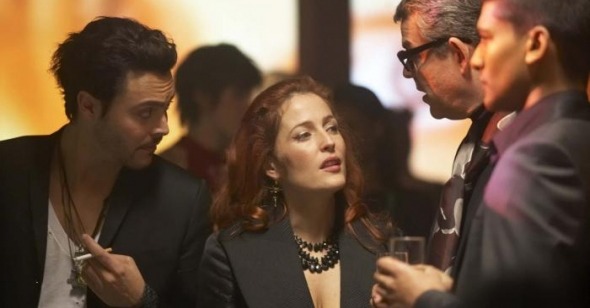Mirror, Mirror
By Farihah Zaman
Boogie Woogie
Dir. Duncan Ward, U.K., IFC Films
A spunky young woman who looks alarmingly like Ray Winstone (the credits reveal that it is in fact the actor’s daughter, Jamie Winstone) chases a Nico-esque blonde (Gemma Atkinson) down the stairs of a rundown converted warehouse apartment building. They argue, the blond telling her lover that she is a terrible artist who can’t even draw a straight line. Her lover lamely, pompously counters that she doesn’t draw, she does video art. Suddenly, they are interrupted by a violent shower of glass from an offscreen accident. Winstone looks horrified for a moment before her face hardens, and she quickly lifts up a camcorder to start filming. This confusing yet cliché introduction nicely encapsulates what’s wrong with Duncan Ward’s Boogie Woogie, a film whose every pointless, clumsy turn only serves to prove its tagline—“There’s an Art to Everything”—untrue.
Boogie Woogie attempts to take a brutally honest look at the dark underbelly of contemporary art and the people who admire, sell, and purchase it. At the center of the web of interconnected plot lines is the titular work by Mondrian. The owners, a man (Christopher Lee) who would rather die than part with the painting, and his wife (Joanna Lumley), who wants to sell it to cover their mounting debt, are inundated with rapidly escalating offers from Danny Huston’s unbearably affected art dealer, who is actually, ill-advisedly, named . . . Art. Meanwhile, Art is also wheeling and dealing wealthy art-collecting couple Jean (Gillian Anderson) and Bob (Stellan Skarsgard), and trying to hang on to his gallery director, Beth (Heather Graham), who’s eager to open a space of her own. Since Beth is sleeping with Bob, he agrees to financially back her new gallery, in which she plans to set up her first discovery, video artist Elaine (Jamie Winstone), the protégé of chronically rejected sad-sack Dewey (Alan Cumming). Beth is unaware that her slimy artist boyfriend, Joe (Jack Huston), is sleeping with Jean. Amanda Seyfried is also involved somehow, presumably to wear preposterously short schoolgirl skirts and get felt up in exceedingly tiresome fashion.
The idea of seduction, greed, and commoditization in the art world may be nothing new, but it’s clear that the film wants to bring a saucy kick to the subject. Unfortunately, Boogie Woogie falls flat at every turn; it’s so fixated on uncovering corruption that the overall effect is one of near joylessness. Even all the sexual drama is too wooden to titillate; rarely is onscreen nudity such a bore, sex so unintentionally unsexy—Elaine’s various exploits are all dutifully recorded for her video self portrait, including a predictable seduction of Beth. Furthermore, the film is tonally confused, trying and failing to be a black comedy, relationship drama, and a witty heist movie; it’s too self-serious to be a spoof but too broadly observed to be a meaningful critique.
Boogie Woogie’s take on the contemporary art scene is also distractingly outdated. The character of Elaine and her callous, narcissistic, barely-a-peg-above-reality-television work is a particular fumble. The intertwining issues of voyeurism, narcissism, sex, and video have been frequently dealt with throughout the Eighties and Nineties in everything from sex, lies and videotape to several Atom Egoyan films, making the positioning of her work as edgy and provocative laughably out of touch. After watching a clip in which Elaine brings home another woman, fucks her in front of her girlfriend, and then aggressively prods her girlfriend about it while smirking at the camera, Heather Graham’s gallery director responds with a dead-eyed “I love it. It’s so real.” I could almost hear the earth creak as it strained to roll its eyes.
Despite the film’s various shortcomings, many of the actors manage to lend appealing, if glaringly wasted, performances. Gillian Anderson is a particular standout, exhibiting the same complex, luminous restraint that she brings to higher end projects like The House of Mirth and BBC’s Bleak House. A scene where she discusses her impending divorce with a friend played by Charlotte Rampling, showing more emotion over the loss of a Brancusi she never even liked than the dissolution of her marriage, is like a momentary glimpse into a different, better film. Alan Cumming gives a fairly realistic, sympathetic portrayal of a man always on the outside looking in—that is, until the writers give him an annoying, hysterical breakdown. There are even a few islands of chuckle-worthy lampoonery, such as the lothario artist who literally, physically ensnares female visitors in the big wooden contraptions that comprise his art, or Skarsgard’s insensitive collector asking Damien Hirst to make a macabre sculpture out of the unborn twin that was excised out of Amanda Seyfried’s character. However, for every clever joke or dead-on observation there are seemingly countless blunders.
Most egregious, however, is the way in which this film about the art world shows little to no dedication to the art itself. It’s easy to criticize the politics behind an aesthetic passion that is also a business, but to do so at such a surface level is pure laziness—the actual art is mostly used as little more than a prop. One could argue that that is in fact the point, but without illuminating the connection between the characters’ depraved antics and the beautiful objects that incite them, the film is unable to move beyond name-dropping. Had Boogie Woogie any measure of wit or charm it might have been an enjoyable, if slight, comedy of errors. Instead, it’s completely graceless, resembling the bad art it seeks to parody all too well.
